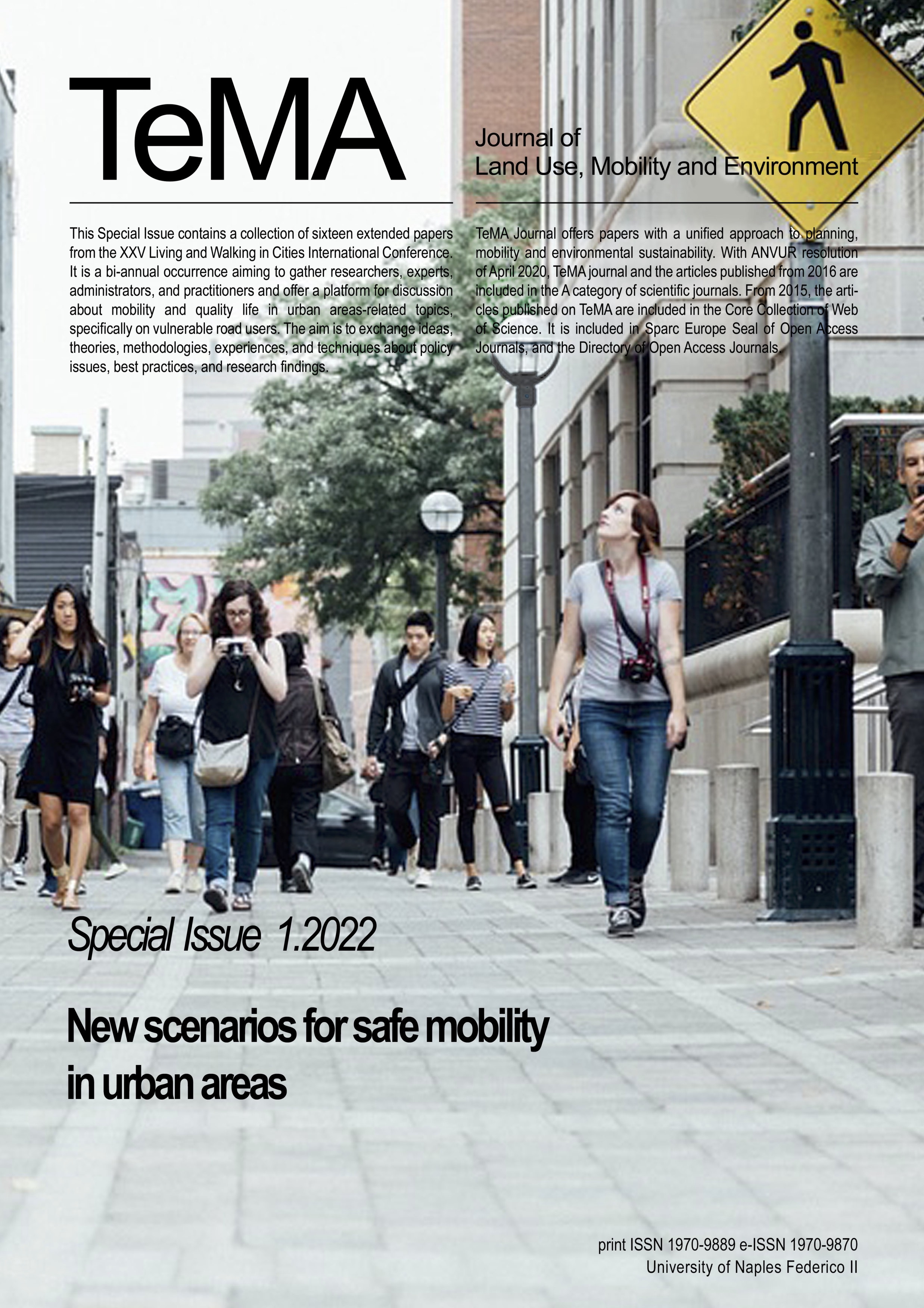The 15-minute city as a hybrid model for Milan
Abstract
With a special focus on Milan, we explore the interpretation of the 15-minute city as a hybrid model, where soft mobility is integrated in a holistic urbanism approach. Contemporary urban challenges, synthetized in the 15-minute city model, look for a sustainable “proximity mix”: mix of uses (overcoming rigid zoning and building codes), mix of inhabitants and users, mix of time schedules and multi-purpose open space. The proposed hybrid approach considers the living-working urban experience as a whole: it proposes to consider, as a starting point for measuring the timeframe of 15 minutes, not only homes but workplaces as well. It welcomes innovative working facilities among those to be considered as essential services reachable within the 15-minute walking timeframe and it integrates open spaces within urban infrastructures by mixing the neighborhood “eco-system” –both of environment and mobility– and designing them around the central role of walking.
Downloads
References
ACI & ISTAT. (2020). Road Accidents: Year 2019. Available at: https://www.istat.it/it/files//2020/07/Road-accidents_2019_EN.pdf
Balletto, G. (2021). Urban Planning, LWC 2021 XXV International Conference Living and Walking in Cities, Brescia, 2021, Transportation Research Procedia, Elsevier, 2022 (in printing)
Boglietti, S., Barabino, B., & Maternini, G. (2021). Survey on e-Powered Micro Personal Mobility Vehicles: Exploring Current Issues towards Future Developments. Sustainability, 13(7), 3692. https://doi.org/10.3390/su13073692
Busi, R. (2021). Opening Talk, LWC 2021 XXV International Conference Living and Walking in Cities, Brescia, 2021, Transportation Research Procedia, Elsevier, 2022 (in printing).
Calthorpe, P. (1993). The Next American Metropolis: Ecology, Community, and the American Dream, Princeton Architectural Press.
Cervero, R.(2004). Around Transit: Strategies and Solutions That Work. Washington, D.C., Urban Land Institute.
Comune di Milano. (2020). Milano 2020 Strategia di adattamento: Documento aperto al contributo della città. [online] Comune di Milano. Available at: https://www.comune.milano.it/documents/20126/95930101/Milano+2020.++Strategia+di+adattamento.pdf
Davies, C., MacFarlane, R., McGloin, C., & Roe, M. (2006). Green infrastructure planning guide, Project technical report. https://doi.org/10.13140/rg.2.1.1191.3688
Deponte, D., Fossa, G., Gorrini, A. (2020). Shaping space for ever-changing mobility. Covid-19 lesson learned from Milan and its region, TEMA Journal of Land Use, Mobility and Environment, Special issue “COVID-19 vs CITY-20 Scenarios, Insights, Reasoning and Research”. Napoli, Edizioni Università Federico II.
European Commission. (2020). Facts and figures pedestrians. European road safety observatory. Brussels, European Commission, Directorate General for Transport.
Fossa, G. (2018). Planning talks, per un nuovo immaginario della città. Milano, Maggioli.
Freudenberg, R. et al. (2021). Re-envisioning the right-of-way, RPA Regional Plan Association, New York.
Global Designing Cities Initiative and National Association of City Transportation Officials. (2016). Global street design guide. Island Press.
Heineke, K., Kloss, B., Scurtu, D. and Weig, F. (2019). Micromobility’s 15,000-mile checkup. Retrieved from McKinsey & Company. Automative & Assembly: https://www. mckinsey. com/industries/automotive-andassembly/our-insights/micromobilitys-15000-mile-checkup.
ITF & OECD. (2020). Road safety report 2020 | Italy. International Transport Forum – OECD. Available at: https://www.itf-oecd.org/sites/default/files/italy-road-safety.pdf
Moreno, C. (2020). Et après? Vie urbaine et proximité à l’heure du Covid-19. Paris, Éditions de l’observatoire/Humensis.
Moreno, C., et al. (2021). Introducing the “15-minute city”: sustainability, resilience and place identity in future post-pandemic cities, Smart Cities, 4, MPDI, Basel.
Paris en Commun. (2020). Ville du 1/4h. Le programme d’Anne Hidalgo. [online]. Available at: https://annehidalgo2020.com/le-programme/.
Scholl, B., Peric, A. and Signer, R. (2018). Spatial planning matters!: inspiring stories and fundamental Topics. vdf Hochschulverlag AG.
Speck, J. (2013). Walkable city: how downtown can save America, one step at a time. New York, Macmillan.
SPRB – Bruxelles Mobilité. (2019). Survey on the use of electric scooters in Brussels. Brussels, Bruxelles Mobilité.
Systematica. (2021). Shifting Paradigm: the impact of Covid-19 on transport planning. Available at: https://issuu.com/systematica/docs/covid19_sys_issuu
Tira, M. (2020). About the Sustainability of urban settlements. TeMA - Journal of Land Use, Mobility and Environment, 361-371. https://doi.org/10.6092/1970-9870/6984
UN General Assembly. (2021). Improving global road safety: Resolution adopted by the General Assembly on 31 August 2020. United Nations. https://undocs.org/en/A/RES/74/299
World Health Organization (2021). Fact sheet: road traffic injuries. World Health Organization. Retrieved November 15, 2021, from https://www.who.int/news-room/fact-sheets/detail/road-traffic-injuries.
Zagorskas, J. and Burinskienė, M. (2020). Challenges caused by increased use of e-powered personal mobility vehicles in European cities. Sustainability, 12(1).
t-Bureau de Recherche. (2019). Uses and users of free-floating electric scooters in France, 158p.
Copyright (c) 2022 TeMA - Journal of Land Use, Mobility and Environment

This work is licensed under a Creative Commons Attribution 4.0 International License.
Authors who publish in this journal agree to the following:
1. Authors retain the rights to their work and give in to the journal the right of first publication of the work simultaneously licensed under a Creative Commons License - Attribution that allows others to share the work indicating the authorship and the initial publication in this journal.
2. Authors can adhere to other agreements of non-exclusive license for the distribution of the published version of the work (ex. To deposit it in an institutional repository or to publish it in a monography), provided to indicate that the document was first published in this journal.
3. Authors can distribute their work online (ex. In institutional repositories or in their website) prior to and during the submission process, as it can lead to productive exchanges and it can increase the quotations of the published work (See The Effect of Open Access)

